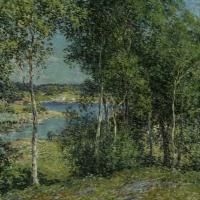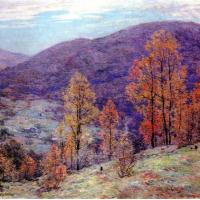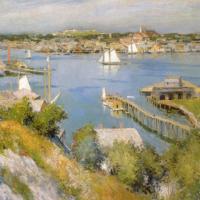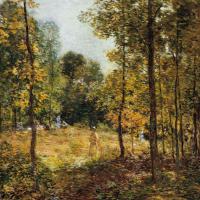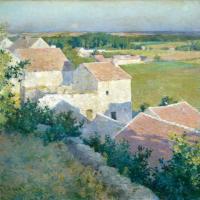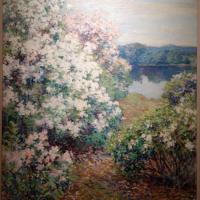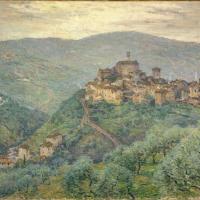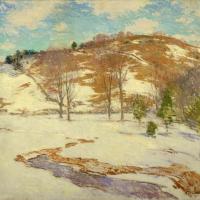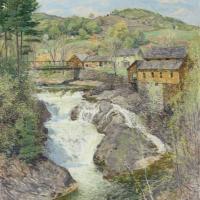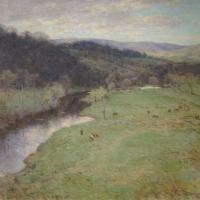Willard Leroy Metcalf
A Family Of Birches
$450.00
Autum Glory
$510.00
Gloucester Harbour
$510.00
Hillside Pastures
$510.00
La Merienda Campestre
$450.00
Midsummer Twilight
$510.00
Mountain Laurel
$450.00
November Mosaic
$510.00
Old Homestead Connecticut
$510.00
Pelago-Tuscany
$510.00
Snow In The Foothills
$510.00
Thawing Brook
$450.00
The Bower
$510.00
The Falls
$450.00
The Ten Cent Breakfast
$480.00
The Twin Birches
$510.00
The Village In Late Spring
$450.00
The White Veil
$510.00
Valley In Spring
$510.00
Willard Leroy Metcalf
Willard Leroy Metcalf (1858-1925)
Willard Leroy Metcalf (July 1, 1858 – March 9, 1925) was an American artist born in Lowell, Massachusetts. He studied at the School of the Museum of Fine Arts, Boston, and later attended Académie Julian, Paris. After early figure-painting and illustration, he became prominent as a landscape painter. He was one of the Ten American Painters who in 1897 seceded from the Society of American Artists. For some years he was an instructor in the Women's Art School, Cooper Union, New York, and in the Art Students League, New York. In 1893 he became a member of the American Watercolor Society, New York. Generally associated with American Impressionism, he is also remembered for his New England landscapes and involvement with the Old Lyme Art Colony at Old Lyme, Connecticut and his influential years at the Cornish Art Colony.
In preparation for a mural commissioned by a tobacco company, Metcalf traveled to Havana, Cuba in 1902, to make painted studies. That year he also produced a series of notable landscapes, including The Boat Landing and Battery Park-Spring. These works were characterized by a new freshness of execution and lightness of palette. In 1904 he resided and painted steadily in Clark's Cove, Maine. By 1905, at the encouragement of his friend Childe Hassam, he began summering in Old Lyme, working as both painter and teacher, and held successful exhibitions in New York and again at the St. Botolph Club. His expertly handled, subtle views of the New England landscape met with steady critical and financial success.
In 1907 May Night (Corcoran Gallery of Art) won the Corcoran gold medal, was honored with the top purchase prize of $3,000, and was the first contemporary American painting to be bought by that institution. It remains one of best works and is now in the collections of the National Gallery of Art. In the same year his marriage to Marguerite dissolved when she eloped from Old Lyme with one of Metcalf's male students.
Metcalf frequently visited the Cornish Art Colony, centered in the villages of Plainfield and Cornish, New Hampshire between 1909 and 1921, often during the quiet winter seasons when many of the colony's residents had returned to the city. The colony stretched over gentle, open hills along the Connecticut River with views of Mount Ascutney in Vermont, a landscape which garnered it comparisons to Tuscany and a crop of Italianate summer homes. In 1909, Louis Shipman, a playwright and husband of landscape architect Ellen Biddle Shipman, invited Metcalf to join him for a winter in Plainfield, at his estate there, Brook Place.
Metcalf would return faithfully for many winters, and at least one summer after that. He was good friends with colonist Charles Platt, on whose Cornish estate he honeymooned, with his second wife, Henriette Alice McCrea-Metcalf in 1911. Varying year to year, he stayed with the Shipmans, or a converted grist mill close to the village of Plainfield. His frequent Cornish muse was Blow-me-down Brook, a small creek which runs through the area, and passed along his residence. Other works depict the hills, the Shipman residence or other country buildings. His production in Cornish exemplified and elevated his reputation for painting modest and intimate scenery of the changing seasons, elements which are represented in his work from the time. The pieces he produced in the Cornish area brought an unusual time of social, critical and commercial success in his life, so often filled with personal tumult. His paintings were compared with the poetry of Robert Frost, Walt Whitman, and other writers, earning him a reputation, in the words of one critic, as the "poet laureate of the New England hills."
While at the colony he painted around 35 landscapes, including Blow-Me-Down (1911), The Village-September Morning (1911) and The White Veil (1909) and the lovely, masterful “Cornish Hills” (1911).
Metcalf continued to hold one-man shows in New York and Boston. During the 1910s he traveled incessantly in search of painting sites. In 1913 he spent nine months painting in Paris, Norway, England, and Italy; in the U.S., in addition to Cornish and Plainfield, New Hampshire, Metcalf lived and painted in Connecticut, Vermont, and Maine, where in 1920 he painted Benediction (now lost), a nocturne. In 1923 the painting sold for $13,000, then a record price for the work of a living American artist.
His familial strife continued when, after having two children, he and Henrietta divorced in 1920, which spurred a period of drinking and decreased productivity. However, he rebounded and painted for a number of years in Vermont, possibly returning briefly to Cornish.
The Corcoran Gallery held a large exhibition of Metcalf's work in 1925, during which the artist died of a heart attack in New York City, on March 6. He was 66.
The Florence Griswold House, where Metcalf visited and stayed in Old Lyme between 1905 and 1907, now houses the largest public collection of Metcalf's paintings and personal artifacts in the world. Additionally, his work is on display in many American museums, including the Metropolitan Museum of Art, the National Gallery of Art, the Art Institute of Chicago, the Boston Museum of Fine Arts, the Detroit Institute of Arts, the Freer Gallery of Art, and recently the Seattle Art Museum. Pieces also appear in some international collections, such as Madrid’s Thyssen-Bornemisza.
His ashes were scattered in Cornish, New Hampshire, by his longtime friend Charles Platt.
Some his notable work:
Summer Morning, Giverny (c. 1888), sold at Christie's for $422,500 in 2010.
Midsummer Twilight (c. 1890, France), at the National Gallery of Art.
May Night (1906), at the Corcoran Gallery, painted in Old Lyme.
The White Veil (1909), Rhode Island School of Design Museum
He painted this in Plainfield by the Shipman house, and later created a second copy, The White Veil (no. 2), now at the Detroit Institute of Arts, upon return to New York. It was among his best winter landscapes and received critical praise at an exhibition with the Ten American Painters.
The Village- September Morning (1911), the Hevrdejs Collection, his only depiction of Plainfield Village.
Benediction (1923), now lost, gained greatest sum for a work by a living American artist.


